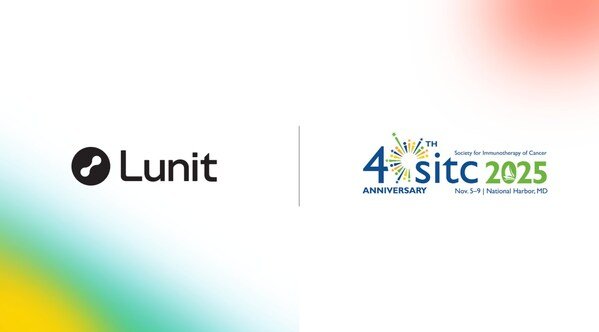Lunit Showcases AI-Powered Digital Pathology Breakthroughs at SITC 2025
10 November 2025 | Monday | News

Studies reveal how the Lunit SCOPE® suite identifies immunotherapy-responsive subtypes, standardizes immune phenotyping, and accelerates antibody-based target discovery
Lunit, a leading provider of AI for cancer diagnostics and precision oncology, announced the presentation of three studies at the Society for Immunotherapy of Cancer (SITC) 40th Annual Meeting, taking place November 5-9 in Maryland, U.S. The findings highlight how Lunit's AI-powered digital pathology technologies—Lunit SCOPE IO® and Lunit SCOPE® uIHC—can advance precision oncology by uncovering predictive immune signatures and guiding antibody-based drug development.
Lunit and CellCarta presented a comparative analysis demonstrating that AI can standardize tumor immune phenotyping across multiple cancer types, including non-small cell lung, colorectal, and urothelial cancers. When assessing tumor and stromal segmentation, Lunit SCOPE IO showed high concordance with pathologist assessments based on traditional immunohistochemistry (Spearman's correlation coefficients of 0.91 and 0.86). Threshold calibration improved alignment between the AI-based and pathologist scoring of inflamed, excluded, and desert immune phenotypes and improved its reliability and reproducibility. These results position Lunit SCOPE IO as a scalable solution for immune profiling, reducing reliance on additional IHC staining and enabling consistent analysis of the tumor immune microenvironment in both research and clinical practice.
Lunit also introduced new data showcasing the utility of Lunit SCOPE uIHC, the company's AI-powered quantitative IHC platform, in mapping spatial interactions between tumor-infiltrating lymphocytes (TILs) and 74 membrane-specific protein targets currently in development for antibody-based therapies such as antibody-drug conjugates (ADCs) and bispecific T-cell engagers (BiTEs). Analyzing over 47,000 IHC images across 34 cancer types, the study revealed that while most protein targets showed decreased TIL density within expression regions, select proteins such as PD-L1 and TNFRSF4, displayed positive spatial correlation with lymphocyte infiltration. Notably, FGFR4 expression was linked to increased intra-tumoral lymphocytes in colorectal, non-squamous lung, and uterine cancers, suggesting its potential as a BiTE target. The findings demonstrate how Lunit SCOPE uIHC can integrate spatial immune context into early drug discovery workflows, accelerating the identification and validation of therapeutic targets.
In another research, Lunit presented new data confirming the predictive power of AI-based spatial profiling in MET-mutated non-small cell lung cancer (NSCLC), demonstrating how AI-powered image-based profiling can uncover immunologically active subtypes within cancers.
"At SITC 2025, we're showcasing how our digital pathology AI, the Lunit SCOPE suite, can bridge research and real-world clinical practice," said Brandon Suh, CEO of Lunit. "From identifying immunotherapy-responsive subtypes to guiding antibody-based drug discovery, our AI technology is redefining how we understand and target the tumor–immune interface. Collaborations like ours with CellCarta are key to unlocking the full potential of this transformation."
Lunit's featured studies at SITC 2025 include:
- Poster Presentation [#1347]: AI-powered image-based spatial profiling of MET-mutated non-small cell lung cancer identifies immune-active MET exon 14 skipping subtypes as potential immunotherapy targets, Zachary Wallen, Labcorp Oncology
- Poster Presentation [#1264]: Artificial Intelligence-Powered Spatial Analysis of Tumor Microenvironment Identifies Immune Phenotypes in H&E Stained Non-Small Cell Lung Cancer, Colorectal Cancer and Urothelial Cancer, Elizabeth Ross, CellCarta
- Poster Presentation [#1098]: Unveiling spatial correlation between cell surface targets and lymphocytes via artificial intelligence (AI)-powered quantitative immunohistochemistry (IHC) analysis, Sukjun Kim, Lunit
Most Read
- How Health Systems Are Reshaping Drug Adoption, Partner Models, and Market Access in 2026
- Top 25 Biotech Innovations Redefining Health And Planet In 2025
- The New AI Gold Rush: Western Pharma’s Billion-Dollar Bet on Chinese Biotech
- Top 25 Biotech & Biopharma Leaders in Sustainable Innovation, 2025
- China’s Biopharma Dealmaking Surges in H1 2025, Driven by Record Licensing and Oncology Focus
- Chikungunya in China: How a “Forgotten” Arbovirus Found the Perfect Storm
- How Innovation Gaps in Biopharma Raise New Safety Concerns
- Smart Implants and the Future of Musculoskeletal Injury Treatment
- How Ethical Gaps in Psychiatry Could Undermine Biopharma Progress
- The Evolving Landscape of Women’s Health Innovation in the Asia-Pacific
- Using NLP-Driven Decision Support in Emergency Health Assistance
- Taiwan Steps Into the Global Spotlight With a New Cancer Therapy
- The Role of Unique Device Identification (UDI) in Tracing Medical Device Safety
- The Importance of a Patient’s Mental Health During Clinical Trials
Bio Jobs
- The State of Biotech and Life Science Jobs in Asia Pacific – 2025
- Avantor’s New CEO Ligner Aims to Unlock Global Potential and Deliver Shareholder Value
- AstraZeneca Commits $50 Billion to U.S. Expansion by 2030 in Biggest-Ever Global Investment
- Thermo Fisher, SAMRC, and South Africa’s Department of Science and Innovation Launch CATIR to Nurture Next-Gen Scientists
- Cube Biotech Appoints Former Sartorius CEO Dr. Joachim Kreuzburg to Board of Directors
- FDA’s AI Transition Marks a Turning Point in Drug Review: Industry Faces Pressure to Adapt Amid 20% Workforce Cut
- WuXi XDC Completes Mechanical Build of Singapore Bioconjugate Manufacturing Hub
News
Editor Picks











